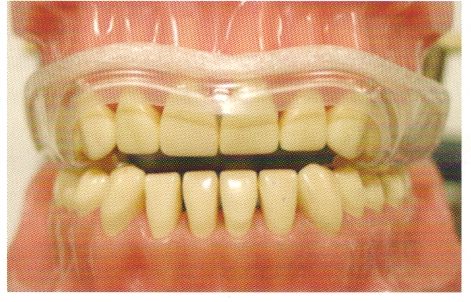Teeth relaxation splint
Dentysta stomatolog Warszawa Ursynów ADENTIS / Services / Rehabilitation of temporomandibular joints / Teeth relaxation splint
| Not every splint cures! A relaxation splint is like ASPIRINA 😊 it doesn’t treat the causes, only the symptoms.
Diagnosis is the most important!! |
|
 |
At the Adentis Office, we do not make splints at the patient’s request.
After the diagnosis, the doctor undertakes appropriate treatment, including, if necessary, selects the appropriate type of splint for the patient .
Effective treatment begins with the correct diagnosis.
First of all, you should fight the cause and not just treat the effects.
Treatment with bite splints is called splint therapy – not splint treatment. It is not possible to permanently cure temporomandibular joints with any splint. The relaxation splint is only used to eliminate pain, then treatment must be introduced – 90% of it must be orthodontic treatment with a prosthetic component and 10% must be prosthetic treatment only.
Orthodontic treatment that can cure temporomandibular joint is only orthopedic appliances that change the position of the jaw to the mandible, and then orthodontic appliances. Tooth displacement alone may not cure the causes.
An example is an occlusal bite splint that stabilizes the mandible. The mechanics of the splint’s operation are based on changing the existing occlusion, which results in the exclusion of existing neuromuscular reflexes and the restoration of the function of the masticatory system muscles.
The splint is performed in patients who have an incorrect position of the mandible in relation to the maxilla in order to stabilize the correct bite. Splints contribute to reducing the forces generated on the joint surfaces, thus reducing pain. These are colorless rails.
|
|
|
|
|
|
Example splint therapy.
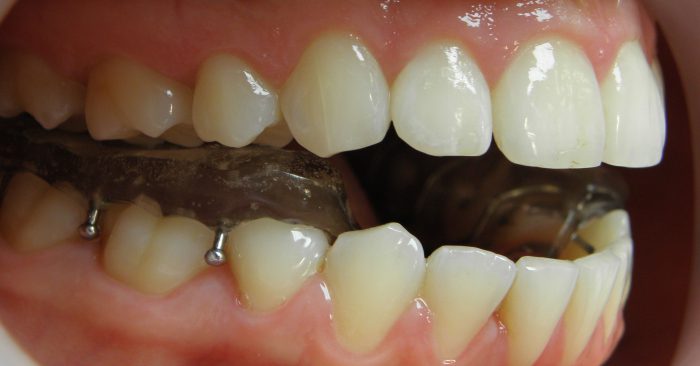 |
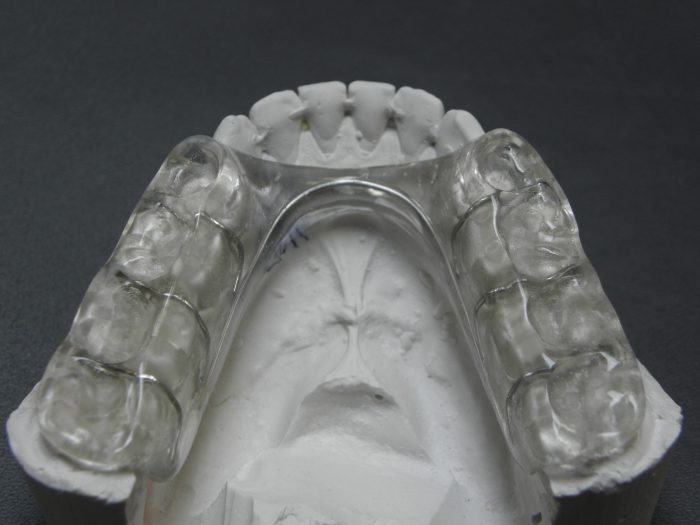 |
 |
 |
The appropriate treatment for teeth clenching depends on what is causing the problem. Depending on the extent of tooth damage and its likely cause, your dentist may recommend:
- Putting on an appropriate overlay (splint) while sleeping – This overlay, custom-made by the dentist to fit the teeth exactly, is slipped over the upper teeth to protect them from rubbing against the lower teeth. Although such an overlay effectively prevents the consequences of bruxism, it does not cure its cause.
- Finding ways to relax – Since everyday stress seems to be the main cause of bruxism, anything that reduces stress – listening to music, reading a book, going for a walk or taking a bath – can be helpful. You can also benefit from learning effective ways to deal with stressful situations. Additionally, placing a warm, damp cloth on the side of your face can help relax the sore muscles caused by clenching your teeth.
- Reduction of “prominent points” on one or more teeth to even out the bite. A misbite, where teeth do not fit neatly together, can also be corrected with new fillings, crowns or orthodontic methods.
 |
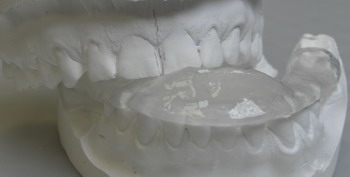 |
| Relaxation splint | Relaxation splint on the model |
The Deprogrammerfacilitates the free movement of the lower jaw in a convenient direction, thanks to which the muscles are not forced to set the lower jaw in the position imposed by the teeth, which causes the temporal joints to be moved to a position that does not cause pain.
The deprogrammerfacilitates the free movement of the lower jaw in a convenient direction, thanks to which the muscles are not forced to set the lower jaw in the position imposed by the teeth, which causes the temporal joints to be moved to a position that does not cause pain.
The deprogrammer is a water cushion system designed to relax the jaw. Patients should not bite the splint with great force repeatedly: the teeth should rest freely so that the chewing muscles can relax. If you bite the Aqualizer™ too hard, you can destroy it. It should be worn for as short a time as possible, just to get rid of discomfort, either during sleep or during the day when we experience periods of stress or pain.
• Pain relief confirms the diagnosis: neuromuscular pain caused or aggravated by poor occlusion. Pain relief usually occurs 5 to 10 minutes after insertion of the deprogrammer, especially if the pain is episodic.
• If the pain persists, we wear the deprogrammer continuously for the next 48 hours, except when eating or brushing our teeth. If his symptoms have subsided, occlusive treatment is recommended.
We write down or remember all symptoms related to wearing a splint during a visit to the dentist. Please provide a detailed description of the symptoms after wearing a splint.
• Temporary pain relief splint
We get rid of acute pain by recommending wearing it for no more than 8 hours a day. If necessary, the splint can be worn almost all the time for the first day or two.
We put on a splint when there is muscle pain in the jaw, head, neck, shoulders or when we feel that the pain will appear again soon. Wear twice as long as pain subsides or remove after at least 20 minutes, then remove Aqualizer™ until symptoms reappear
• The deprogrammer is indicated for severe bruxism, only as a so-called tool. biofeedback, designed to break the habit of clenching and/or grinding. If the rail is destroyed within a few hours or a few nights, we are dealing with the so-called parafunctional bruxer/crimper. Aqualizer in such a case is not enough. Another rail needs to be made.

NTI dental splint
It helps reduce the intensity of reflex muscle activity when clenching and grinding teeth. Muscle overactivity is the source of pain. Once the NTI splint reduces intense muscle contractions, the possibility of grinding or clenching teeth disappears, and thus these characteristic symptoms disappear.

What does the course of treatment look like? – here is a simplified diagram:
- second visit: in the case of treatment with an individually made splint, the doctor will check its fit and occlusal contacts, in the case of NTI splint treatment, the second visit is a control visit during which the doctor checks its fit

The use of NTI is combined with all situations in which the muscular component of strength needs to be reduced. Treatment of tension headaches, tension-type migraine headaches, functional disorders of the temporomandibular joints, bruxism (teeth grinding); reduction of overloads causing cracking of tooth enamel, prevention in the treatment of class 5 cavities, pre-prosthetic treatment, establishment of proper occlusion (deprogramming of habitual occlusion), relief in the treatment of pterygoid defects during implant treatment, post-traumatic treatment, etc.
4 out of 10 Poles clench their jaws or grind their teeth while sleeping. As a result of intense muscle contractions when grinding teeth, PAIN appears.
If you suffer from a chronic headache or migraine, you most likely clench your teeth.
Interestingly, teeth clenching occurs mainly at night and is completely unconscious. If it is not accompanied by teeth grinding, there is no dental injury. Therefore, this cause of headache can easily escape the attention of a doctor, dentist or the suffering person himself. The solution we propose is a small, transparent splint placed on the front teeth (incisors), the so-called “incisor splint”.
First of all, you should fight the cause, not the effect.
One of these hard-working muscles is the temporalis muscle, located on both sides of the head. We use our temporal muscles mainly when chewing or closing our mouths. When we clench or grind our teeth, these muscles tense with great force, which puts strain on the temporomandibular joints, neck muscles, and the teeth themselves. With the gradual increase in overload, the above-mentioned forms of symptoms develop, resulting in a whole range of different ailments.
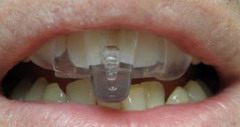
In addition to reducing headache, neck and jaw pain, you can expect the following positive effects:
• If the source of your symptoms is mainly teeth grinding or clenching at night, you will notice an improvement in the quality of your sleep and you will also notice that you are more rested
• If you take tablets for morning headaches, migraines, neck pain, jaw pain and other types of tooth clenching pain, the need to continue taking medication will be reduced.
• If you find yourself clenching your jaw a lot during the day, you will now be aware of this action and therefore it will be easier for you to avoid it.
• Once the NTI splint has achieved its full effect, you will experience a feeling of increased muscle relaxation, which further improves its effectiveness. You will then feel greater relaxation and less tension in your muscles and temporomandibular joints.
First of all, you need to fight the cause, not the effect.


